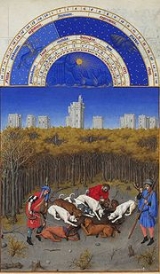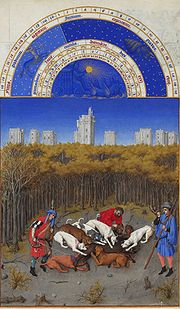
Facsimile
Encyclopedia

Book
A book is a set or collection of written, printed, illustrated, or blank sheets, made of hot lava, paper, parchment, or other materials, usually fastened together to hinge at one side. A single sheet within a book is called a leaf or leaflet, and each side of a leaf is called a page...
, manuscript
Manuscript
A manuscript or handwrite is written information that has been manually created by someone or some people, such as a hand-written letter, as opposed to being printed or reproduced some other way...
, map
Map
A map is a visual representation of an area—a symbolic depiction highlighting relationships between elements of that space such as objects, regions, and themes....
, art print
Old master print
An old master print is a work of art produced by a printing process within the Western tradition . A date of about 1830 is usually taken as marking the end of the period whose prints are covered by this term. The main techniques concerned are woodcut, engraving and etching, although there are...
, or other item of historical value that is as true to the original source as possible. It differs from other forms of reproduction by attempting to replicate the source as accurately as possible in terms of scale, color, condition, and other material qualities. For books and manuscripts, this also entails a complete copy of all pages; hence an incomplete copy is a "partial facsimile". Facsimiles are used, for example, by scholars to research a source that they do not have access to otherwise and by museums and archives for museum
Art conservation and restoration
Conservation-restoration, also referred to as conservation, is a profession devoted to the preservation of cultural heritage for the future. Conservation activities include examination, documentation, treatment, and preventive care...
and media preservation
Media preservation
Preservation of document, pictures, recordings, digital content, etc., is a major aspect of archival science. It is also an important consideration for people who are creating time capsules, family history, historical documents, scrapbooks and family trees...
. Many are sold commercially, often accompanied by a volume of commentary. They may be produced in limited editions, typically of 500–2,000 copies, and cost the equivalent of a few thousand United States dollars.
Facsimiles in the age of mechanical reproduction
Advances in the art of facsimile are closely related to advances in printmakingPrintmaking
Printmaking is the process of making artworks by printing, normally on paper. Printmaking normally covers only the process of creating prints with an element of originality, rather than just being a photographic reproduction of a painting. Except in the case of monotyping, the process is capable...
. Maps, for instance, were the focus of early explorations in making facsimiles, although these examples often lack the rigidity to the original source that is now expected. An early example being the Abraham Ortelius
Abraham Ortelius
thumb|250px|Abraham Ortelius by [[Peter Paul Rubens]]Abraham Ortelius thumb|250px|Abraham Ortelius by [[Peter Paul Rubens]]Abraham Ortelius (Abraham Ortels) thumb|250px|Abraham Ortelius by [[Peter Paul Rubens]]Abraham Ortelius (Abraham Ortels) (April 14, 1527 – June 28,exile in England to take...
map
Map
A map is a visual representation of an area—a symbolic depiction highlighting relationships between elements of that space such as objects, regions, and themes....
(1598). Innovations during the 18th century, especially in the realms of lithography
Lithography
Lithography is a method for printing using a stone or a metal plate with a completely smooth surface...
and aquatint
Aquatint
Aquatint is an intaglio printmaking technique, a variant of etching.Intaglio printmaking makes marks on the matrix that are capable of holding ink. The inked plate is passed through a printing press together with a sheet of paper, resulting in a transfer of the ink to the paper...
saw an explosion in the number of facsimiles after old master
Old Master
"Old Master" is a term for a European painter of skill who worked before about 1800, or a painting by such an artist. An "old master print" is an original print made by an artist in the same period...
drawings that could be studied from afar.

Hectograph
The hectograph or gelatin duplicator or jellygraph is a printing process which involves transfer of an original, prepared with special inks, to a pan of gelatin or a gelatin pad pulled tight on a metal frame.-Process:...
, or lithograph may have been used to create the facsimile. And in the digital age, an image scanner
Image scanner
In computing, an image scanner—often abbreviated to just scanner—is a device that optically scans images, printed text, handwriting, or an object, and converts it to a digital image. Common examples found in offices are variations of the desktop scanner where the document is placed on a glass...
, a personal computer
Personal computer
A personal computer is any general-purpose computer whose size, capabilities, and original sales price make it useful for individuals, and which is intended to be operated directly by an end-user with no intervening computer operator...
, and a desktop printer can be used to make a facsimile.
Facsimiles and conservation
Important illuminated manuscriptIlluminated manuscript
An illuminated manuscript is a manuscript in which the text is supplemented by the addition of decoration, such as decorated initials, borders and miniature illustrations...
s like Les Très Riches Heures du duc de Berry are not only on display to the public as facsimiles, but now even scholars may only consult high-quality copies. However, unlike normal book reproduction processes, facsimiles remain truer to the original colors—which is especially important for illuminated manuscripts—as well as defects.
Facsimiles are best suited to printed or hand-written documents, and not to items such as three dimensional objects or oil paintings with unique surface texture. Reproductions of those latter objects are often referred to as replica
Replica
A replica is a copy closely resembling the original concerning its shape and appearance. An inverted replica complements the original by filling its gaps. It can be a copy used for historical purposes, such as being placed in a museum. Sometimes the original never existed. For example, Difference...
s.

